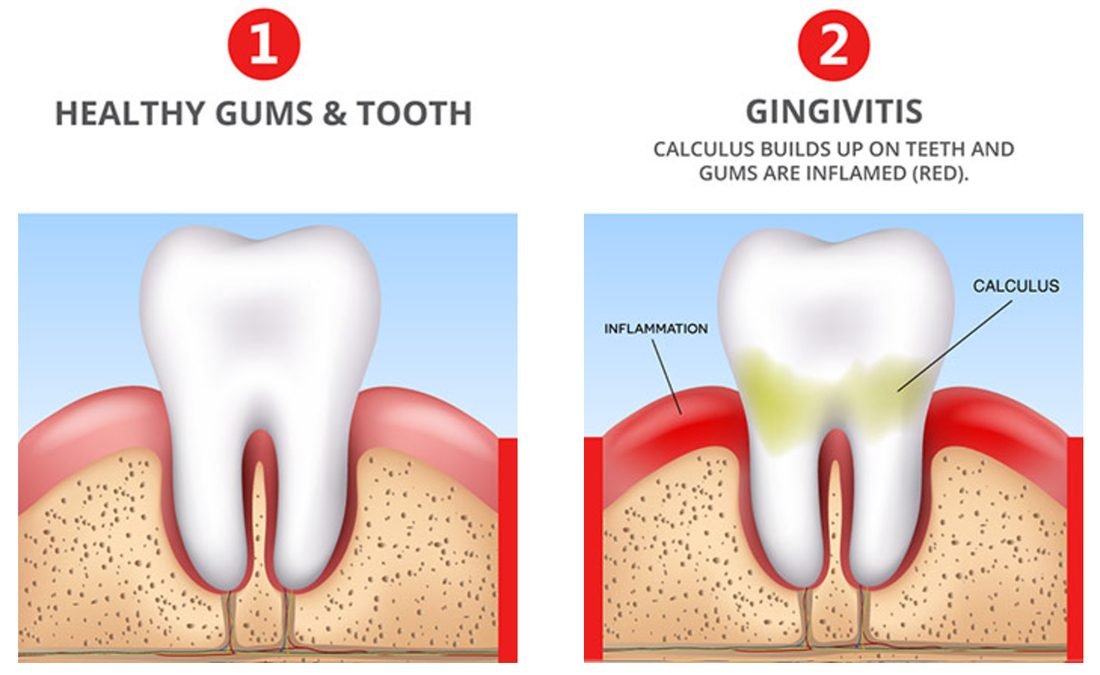
What is dental hygiene?
Dental hygiene is the foundation of dentistry by implementing habits and practices of maintaining or improving the health of the teeth, periodontium, gums, and overall health. Oral health affects our ability to eat, speak, smile, and show emotion which is what brings us all together. Dental hygiene is important because it is preventive care and is the window to our overall body health.
What is gingivitis?
Gingivitis is the inflammation of the gingiva (gums) it is the earliest sign of gum disease. Gingivitis causes redness, irritation, bleeding, and swelling. The most common cause of gingivitis is poor oral hygiene it is also important to note that it is reversible, and if it is not treated it can lead to periodontitis a more serious gum disease and tooth loss. About 47% of adults in the United States have a form of gum disease.
Signs and Symptoms
Inflamed, swollen, puffy gums
Dark pink or dark red gums
Bleeding when brushing or flossing
Sensitive or tender gums
Bad breath
Plaque or calculus build-up
Causes
There are a few contributing factors that cause gingivitis the most common is poor oral hygiene. Poor oral hygiene allows bacteria such as plaque to form on teeth and cause inflammation around the gum tissue.
Plaque formation begins as a soft, sticky, film substance that is composed of bacteria that forms on your teeth when sugar and starches from food interact with bacteria already in the mouth. The plaque will feed off of the sugar and starches and produce acids. Plaque is detectable in 8-24 hours if not disrupted frequent removal is necessary to reduce and eliminate plaque.
Plaque turns into calculus when it starts to be calcified and accumulates if it is not being removed frequently or effectively. Calculus (tartar) is composed of primarily calcium phosphates and mineral salts. Plaque can take 8-12 hours to harden into calculus and starts to mineralize within 10-12 days.
Inflammation of the gums (gingivitis) starts to occur when plaque and calculus are surrounding the tooth the gums are the first to be induced in swollen, tenderness, bleeding, and redness which are early signs of gum disease that is preventable and reversible if treated immediately.
Risk Factors
Poor oral hygiene
Dry mouth
Smoking/chewing tobacco/pouches
Poor nutrition/diet
Medications
Hormonal changes such as puberty, pregnancy, menstrual cycle, birth control, and menopause
Dental restorations that need repair or don’t properly fit-old fillings, crowns or crooked teeth that are hard to clean
Medical conditions that decrease immunity and fungal or viral infections
Genetics
Prevention
Good oral hygiene routine. Brushing frequently at least 2 times a day for about 2 minutes and flossing at least 1 time a day. Implement brushing your tongue as it collects several bacteria throughout the day. Create a good oral hygiene routine first thing in the morning and at night time right before bed or before your last snack or drink. Speak to your dental hygienist and dentist about the best practice for you.
Regular dental visits. It is important to see your dental hygienist and dentist regularly every 6 to 12 months or in some cases, it is every 3-4 months. It helps decrease the chance of gum disease and any early signs of other health-related conditions. Oral cancer screenings are performed at every dental hygiene visit and dental exam. Annual radiographs (X-rays) are essential to help identify and monitor any diseases that are not visually seen clinically.
Balance overall health. A well-balanced diet, healthy eating habits, exercises-manging blood pressure, blood sugar, etc. all contribute to our systemic overall health. More smiles less stress.
What is periodontitis?
Periodontitis is a chronic inflammation around the supporting structures of the teeth and there are different stages in severity. It is a serious form of gum disease that may cause teeth to loosen or lead to tooth loss. It is not reversible once there is damage to the bone structure but can be maintained with proper care. It is important to go to your dental visits for routine periodontal maintainces. Speak to your dental specialists if you have any questions or concerns about your oral health.
Signs and Symptoms
Red or purplish swollen gums
Bad breath or odor that does not go away
Tender or sensitive gums
Bleeding when brushing or flossing
Recession on gums or longer-appearing teeth
Loose teeth/ tooth loss
Pus
Causes
Poor oral hygiene which leads to plaque, and calculus build-up (bacteria) is the leading cause of periodontitis. Bacteria will build up beneath the gums where toothbrushes or floss can not reach. Visiting your dentist and dental hygienist routinely is important for the removal of harmful bacteria that will erode and destroy the tissue supporting the teeth. There are other contributing factors that cause periodontitis.
Risk Factors
Poor oral hygiene
Smoking
Crooked Teeth
Lack of regular dental/dental hygiene visits
Diabetes
Immunodiffinciecies
Medications may cause dry mouth
Hormonal changes-pregnancy, menopause, oral contraceptives, etc.
Genetics
Prevention
Good oral hygiene habits- brushing 2 times daily and flossing regularly. Creating a solid foundation in oral hygiene routine
Regular dental visits and dental hygiene appointments to monitor and clean beneath the gums and maintain an overall healthy mouth.
A well-balanced diet and exercise
Waterpik/water flosser- studies have shown improvement in oral health by reducing plaque, bleeding, and inflammation of gums.
REFERENCES
1. Centers for Disease Control and Prevention. (2013, July 10). Periodontal disease. Centers for Disease Control and Prevention. Retrieved May 1, 2023, from https://www.cdc.gov/oralhealth/conditions/periodontal-disease.html
2. Calculus - an overview | ScienceDirect Topics (2018) Calculus. An overview | ScienceDirect Topics. Retrieved March 17, 2023, fromhttps://www.sciencedirect.com/topics/medicine-and-dentistry/calculus-dental
3. Mayo Foundation for Medical Education and Research (2017, August 4) Gingivitis. Mayo Foundation for Medical Education and Research. Retrieved April 16, 2023, from https://www.mayoclinic.org/diseases-conditions/gingivitis/symptoms-causes/syc-20354453

